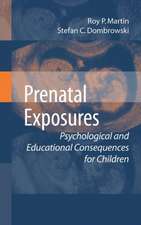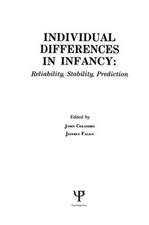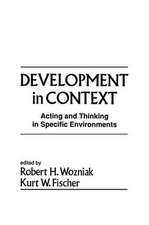The Developing Structure of Temperament and Personality From Infancy To Adulthood
Editat de Charles F. Halverson, Jr., Gedolph A. Kohnstamm, Roy P. Martin, Charles F. Halverson, Geldolph A. Kohnstammen Limba Engleză Paperback – sep 1994
Written by some of the most distinguished scholars from Great Britain, continental Western Europe, and Eastern Europe as well as the United States and Canada, the chapters present a cross-cultural view of both adult personality and temperament in infancy and childhood. By sharing their recent data, techniques, and theoretical speculations, the chapter authors communicate the research enthusiasm engendered by the growing consensus of the adult "Big Five" as well as the exciting prospects of an integrative program of research from infancy to adulthood that will clarify and consolidate what is now a disparate set of methods, theory, and findings across the lifespan. The editors suggest that this volume will have considerable heuristic value in stimulating researchers to conceptualize their work in developmental, lifespan approaches that will lead to a consolidation of individual differences research at every age.
Preț: 510.36 lei
Preț vechi: 600.43 lei
-15% Nou
Puncte Express: 766
Preț estimativ în valută:
97.66€ • 106.41$ • 82.29£
97.66€ • 106.41$ • 82.29£
Carte tipărită la comandă
Livrare economică 23 aprilie-07 mai
Preluare comenzi: 021 569.72.76
Specificații
ISBN-13: 9780805816693
ISBN-10: 0805816690
Pagini: 440
Dimensiuni: 152 x 229 x 28 mm
Greutate: 0.73 kg
Ediția:1
Editura: Taylor & Francis
Colecția Psychology Press
Locul publicării:Oxford, United Kingdom
ISBN-10: 0805816690
Pagini: 440
Dimensiuni: 152 x 229 x 28 mm
Greutate: 0.73 kg
Ediția:1
Editura: Taylor & Francis
Colecția Psychology Press
Locul publicării:Oxford, United Kingdom
Public țintă
ProfessionalCuprins
Contents: Preface. Part I: Current Conceptions of the Structure of Adult Personality. L.R. Goldberg, T.K. Rosolak, The Big Five Factor Structure as an Integrative Framework: An Empirical Comparison with Eysenck's P-E-N Model. H.J. Eysenck, The Big Five or Giant Three: Criteria for a Paradigm. M. Zuckerman, An Alternate Five-Factor Model for Personality. A. Angleitner, F. Ostendorf, Temperament and the Big Five Factors of Personality. B. De Raad, A.A.J. Hendriks, W.K.B. Hofstee, The Big Five: A Tip of the Iceberg of Individual Differences. A.T. Panter, J.S. Tanaka, R.H. Hoyle, Structual Models for Multimode Designs in Personality and Temperament Research. P.T. Costa, Jr., R.R. McCrae, Stability and Change in Personality From Adolescence Through Adulthood. Part II: Emerging Conceptions of the Childhood Precursors of Personality Structure. R.P. Martin, J. Wisenbaker, M. Huttunen, Review of Factor Analytic Studies of Temperament Measures Based on the Thomas-Chess Structural Model: Implications for the Big Five. W.O. Eaton, Temperament, Development and the Five-Factor Model: Lessons From Activity Level. S.A. Ahadi, M.K. Rothbart, Temperament, Development and the Big Five. T.D. Wachs, Fit, Context, and the Transition Between Temperament and Personality. Part III: Deriving the Five-Factor Model From Parental Ratings of Children and Adolescents. B. Hagekull, Infant Temperament and Early Childhood Functioning: Possible Relations to the Five-Factor Model. H.H. Goldsmith, S.H. Losoya, D.L. Bradshaw, J.J. Campos, Genetics of Personality: A Twin Study of the Five-Factor Model and Parent-Offspring Analyses. R.W. Robins, O.P. John, A. Caspi, Major Dimensions of Personality in Early Adolescence: The Big Five and Beyond. C.F.M. van Lieshout, G.J.T. Haselager, The Big Five Personality Factors in Q-Sort Descriptions of Children and Adolescents. Part IV: Deriving the Five-Factor Model From Teacher Ratings of Children and Adolescents. J.M. Digman, Child Personality and Temperament: Does the Five-Factor Model Embrace Both Domains? W.G. Graziano, The Development of Agreeableness as a Dimension of Personality. J.B. Victor, The Five-Factor Model Applied to Individual Differences in School Behavior. Part V: A Research Agenda for the Study of Personality and Temperament in Childhood Based on Free Description. V.L. Havill, K. Allen, C.F. Halverson, G.A. Kohnstamm, Parents' Use of Big Five Categories in Their Natural Language Descriptions of Children. I. Mervielde, A Five-Factor Model Classification of Teachers' Constructs on Individual Differences Among Children Ages 4 to 12. A.W. Goedhart, A. Treffers, G.A. Kohnstamm, The Five-Factor Model in Child Psychiatry: Parents' Free Personality Descriptions of Their Children.
Notă biografică
Charles F. Halverson Jr., Gedolph A. Kohnstamm, Roy P. Martin, Charles F. Halverson, Geldolph A. Kohnstamm














